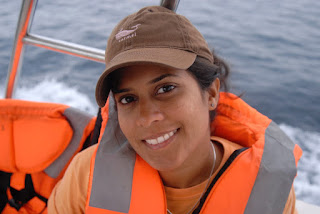This post is one of a series on projects supported by the
Aquarium’s Marine Conservation Action Fund (MCAF). Through MCAF, the Aquarium supports researchers, conservationists and grassroots organizations all around the world as they work to address the most challenging problems facing the ocean.
Dr. Asha de Vos will be visiting the Aquarium November 7-13 as the first of nine Ocean
Conservation Fellows, under a program funded by the Institute of Museum and Library Services to connect field conservation work from around the world with the Aquarium's local programs and audiences. She will deliver a free public lecture, "Saving the Unorthodox Whales of Sri Lanka," on November 12, 2015.
 |
| MCAF grantee Asha de Vos, Ph.D., is a TED Senior Fellow and a World Economic Forum Young Global leader. Photo: Yasha Hetzel |
The trouble, says Sri Lankan marine biologist and MCAF grantee Asha de Vos, PhD, is that the southern coast of Sri Lanka is also home to one of the busiest shipping lanes in the world. Several North Indian Ocean (NIO) blue whales have died in documented collisions with ships in recent years. These reports are likely “just a fraction of the individuals who get hit and killed in this manner, given that most carcasses either sink or get pushed offshore,” says de Vos.
 |
| Photo-identification methods help de Vos recognize individual blue whales and estimate the size of the NIO population. Photo: Steve deNeef |
The NIO whales “speak a different dialect, are about 20 feet shorter than their Antarctic counterparts (who can grow to about 100 feet) and display different behaviors than other populations,” says de Vos.
Her research suggests that the whales may not need to migrate long distances because oceanographic processes keep their home waters productive throughout the year. “The key thing is that Sri Lanka is situated in the heart of the Northern Indian Ocean, which experiences a monsoonal climate,” says de Vos. During the two monsoons, two different processes bring cold, nutrient-rich water toward the surface. The result is a year-round buffet for the whales.
 |
| Dr. De os (far left) and her research team survey the Northern Indian Ocean for marine life. Photo: Steve De Neef |
Beyond studying the behavior of this unique population, de Vos is currently working to reduce the risk of whale death by ship strike. With partial support from MCAF, de Vos is assessing risk to this population over a broad area and is testing the results of a computer model to predict where blue whale habitats might overlap with shipping lanes in areas that aren’t accessible to survey vessels. With this information in hand, it may be possible to adjust shipping lanes to reduce the threat of ship strikes.
More information on Asha de Vos:
Free Aquarium Lecture: November 12, 2015
TED Talk: Why You Should Care About Whale Poo
New York Times Video: Saving Blue Whales



0 comments:
Post a Comment